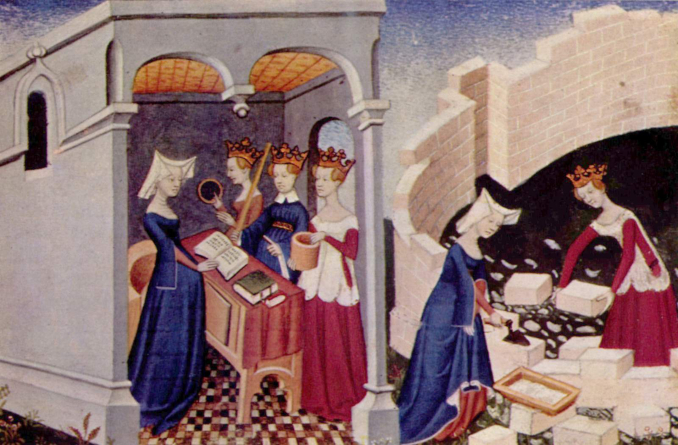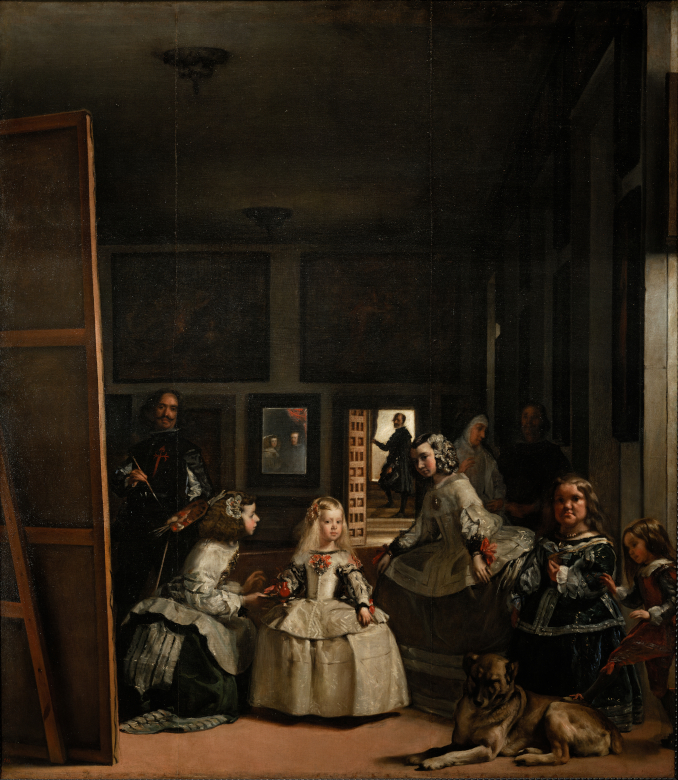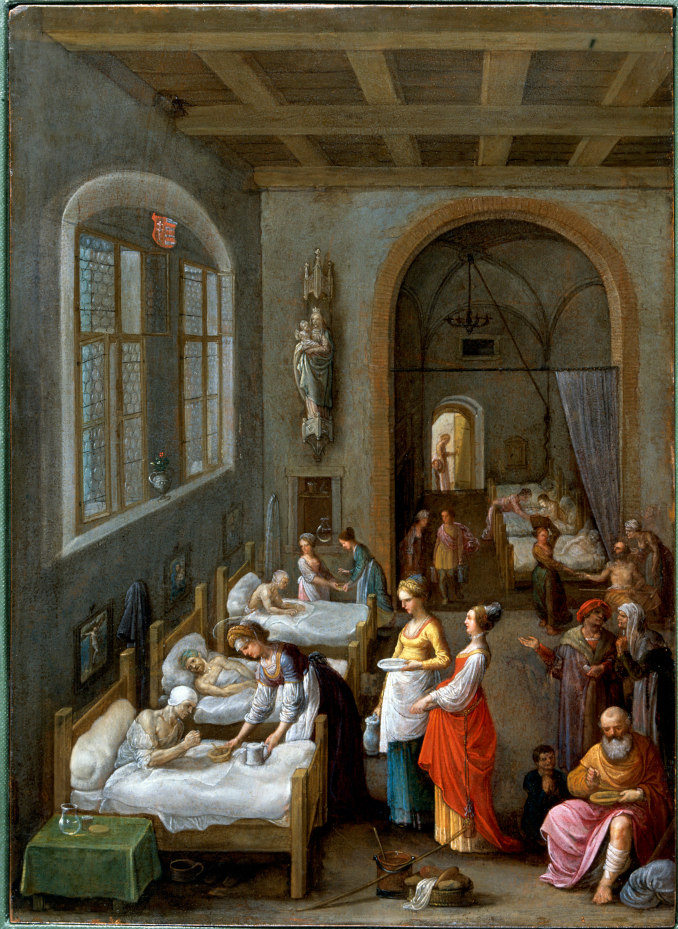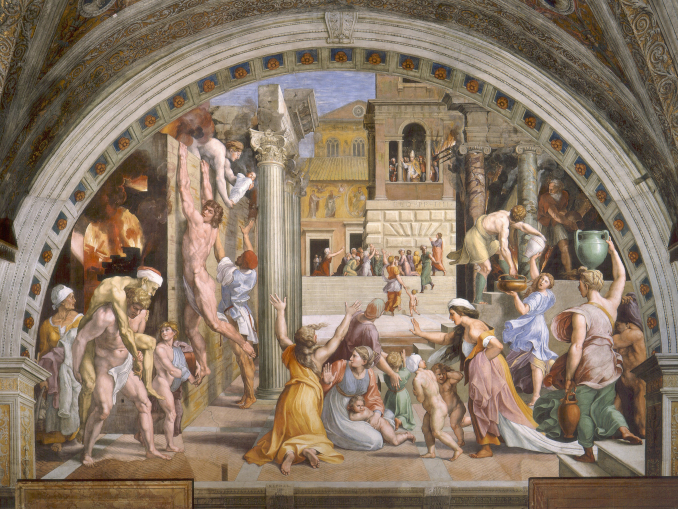Food for the Soul- Women at Work, Part V – Princesses and Servants

Book of the City of Ladies. Christine de Pizan (c. 1405). Bibliothèque Nationale de France, Paris. Photo: Wikimedia Commons
By Nina Heyn – Your Culture Scout
We do not know who illustrated the Book of the City of Ladies, but we know the author: Christine de Pizan (or de Pisan). This miniature portrays her as the woman in a blue dress who is placing a hand on her book and receiving the Lady of Reason (with a mirror), Lady Rectitude (with a ruler), and Lady Justice (with a measuring cup). This is also an allegory of de Pizan setting out to write her book, which is metaphorically imagined as the construction of a wall, using a “spade of intelligence” and a “mortar of ink” in a “field of letters.” Real princesses would not have been doing masonry, but this symbolic portrayal of the creative process and writing remains as relevant today as it was then—we still refer to “building sentences” and “constructing a story.” What is more unusual, of course, is the fact that de Pizan was a woman writing at the end of the Middle Ages; at the time, educated women might have written letters or personal poems, but not actual books—and they certainly would not have written books as a way to earn a living.
De Pizan came from Italy with her father, an astrologer, to the Parisian court of King Charles V. There, she had a happy marriage and three children, but by age 25, she found herself widowed. Having lost all three of her protectors—her husband, her father, and her royal patron—she then spent decades trying to survive by writing and copying, all the while taking care of her children and relatives. All of this took place during the Hundred Years War—not the easiest time for anyone to survive.
De Pizan never remarried, and her single status actually became her professional weapon—as master of her own time and decisions, she could devote herself to intellectual pursuits. She could also retreat to her own room (a rarity in those times) to study and compose her writings, eventually becoming not only an accomplished poet but also a commissioned writer of the king’s biography. Having experienced first-hand what it was like to live without the usual (in her time) safety net of men providing income and protection, de Pizan wrote this book in defense of women’s value in society. In it, she lists numerous famous women—from mythological Amazons to the Empress Theodora, and from all the saints to all the queens (165 women altogether)—whose achievements and virtues rivaled those of men. Her book was also a response to a very popular allegory, the Romance of the Rose; the medieval love story had been started as a typical romantic poem, but it was completed by a different author, a misogynist who criticized women as wanton, false, and useless creatures. City of Ladies was copied and illustrated in Paris under de Pizan’s supervision. The fact that such manuscripts were precious enabled the author to make a living from their production. Toward the end of her life, de Pizan retreated to a convent, a rare safe place during the raging conflicts of the never-ending war. Her last poem was written in 1429 in praise of Joan of Arc—another brave woman who proved her worth against male warriors.

Las Meninas. Diego Velázquez (c. 1656). The Prado, Spain. Photo: Wikimedia Commons
Las Meninas (The Maids of Honor) was a celebrated canvas from its very beginning. The centerpiece is a portrait of the Infanta Margarita Teresa, royal princess and daughter of King Philip IV, and the painting immediately entered the Spanish royal collection. It is one of the most complex compositions in the history of art, showing a group of people in the center, a figure in the back, and—reflected in the mirror—the royal couple of Philip IV and Queen Mariana. The mirror either reflects them as they enter the room, or perhaps it just reflects their portrait that the artist is creating on a big easel. This is also a commentary on the art of painting, as well as an optical illusion (which every painting is, by its very nature) and a discourse on Velázquez’s position as an artist-creator rather than just an artisan.
There have been countless books and dissertations written about this painting all over the world, and Picasso painted about 40 variations on the theme of this painting. However, we can also just examine this quite familiar masterpiece from the point of view of the people who appear in it. Here, we have both princesses and servants; the royals; courtiers; and a special royal servant in the person of Velázquez. The little crown princess is standing stiffly, turning her head away from a kneeling maid and a jug that is being offered to her. This is not really an ordinary five-year-old child; this is someone trained from toddlerhood to command, to keep straight and immobile when the occasion demands, and to treat her entourage as servants. She knows not to smile in public, and she would never attempt any carefree holding of hands. She may have amusing companions—a massive but docile dog and a pair of little people (the Spanish court was famous for its precious dwarves)—but her dress and posture are regal and formal. Infanta’s parents are also in this picture. We only see them indistinctly in the mirror (what a brave way to portray a royal patron), and then we can infer that Velázquez is painting them in the huge canvas in front of him. Thanks to this “picture-within-a-picture” structure, we have three royals in one room (the royal couple are either in person or in the painting reflected in the mirror) and a retinue of the titular meninas and various courtiers.
However, the most important royal servant here is Velázquez himself. This was 17th-century Spain, ruled over by an absolute monarch whose wealth came from military conquests and whose right to rule—viewed as ordained by God—meant that everyone in his kingdom was his servant. Unlike a free-spirited artist of the 21st century (who might take on a commission but otherwise be a respected and famous person), a 17th-century painter like Velázquez would have been considered a craftsman—perhaps admired for his work but with a position at the royal court that amounted to little more than being a wall decorator, with no military power, no noble title, and no independence. As a result, Velázquez was quite obsessed with social advancement and always in pursuit of ennoblement; toward the end of his life, he spent more time being the marshal of the royal household than as an artist. In this virtuoso painting, ostensibly just a portrait of a little princess, he positions himself as different from the royal servants—he is in the process of creating an artwork that will outlast all the royals in the picture. And so it did.

St. Elizabeth Visiting the Hospital. Adam Elsheimer (c. 1598). Photo: Wellcome Library, London. Wellcome Images images©wellcome.ac.uk via Wikimedia Commons
St. Elizabeth was a 13th-century royal princess who became venerated for her devotion in serving the needs of the poor. Daughter of the king of Hungary, she married a German duke at age fourteen, bore him three children, and, after a few years of happy marriage, was widowed at the age of 20. Left in a castle with her disapproving mother-in-law, she sought refuge in her piety. From a young age, Elizabeth was heavily influenced by the order of the Franciscans and the idea of service to the poor and the sick. An apocryphal story of her sainthood tells of her meeting her husband when she is carrying some bread for the poor. Knowing that her husband disapproves of her excessive engagement with the affairs of the lower classes, she lies to him, saying that she is just carrying roses. When he makes her disclose what she is hiding underneath her cloak, lo and behold, she is found to be holding a bouquet. This is the so-called “miracle of roses of St. Elizabeth.” Apocryphal stories aside, Elizabeth was famous for renouncing her royal birth and princely status in favor of humble service to the poor. Her charitable work culminated in her founding and running a hospital and a shelter. Unfortunately, she did not last long; after exposure to leprosy and other diseases, she died at age 24.
A 16th-century painting by Adam Elsheimer immortalized this role of St. Elizabeth as a tireless caregiver. Elsheimer was a very “international” artist (born German, worked in Italy, passionately collected in England, influenced Rubens and other Dutch artists).The full title of this small painting is Saint Elizabeth Offers a Bowl of Food and a Tankard of Drink to a Male Patient in the Hospital in Marburg, Germany. St. Elizabeth, identified with a halo, bends over a sick patient while two of her assistants wait behind her with some bowls. Elsheimer paints a lot of realistic details—a pisspot under the bed, a rope to pull down a chandelier for changing candles, bandages on a patient’s leg. Despite their avowed humility in service to the poor, the three ladies are dressed in the full splendor of colorful gowns, and there are other beautiful splashes of color, such as the green velvet of a tablecloth and the pink-orange robes of a man sitting in the front. Elsheimer made full use of the copperplate on which this oil was painted. Copper backing was not often used in paintings but it allowed for vivid colors and the picture’s glossy sheen.

The Fire in the Borgo. Raphael (1516). Stanza dell’Incendio, Vatican. Photo: Wikimedia Commons
This is the last painting in the “Women at Work” series, following the principle that you leave the best for last. Raphael does not need much introduction, since any art lover is familiar with his exquisite Madonnas, portraits, and religious scenes. He spent decades decorating the Vatican walls, first for Pope Julius II and then for his successor, Pope Leo X, who was installed in 1513. A year later, Raphael, who already had under his belt the decorations for three other rooms, including The School of Athens, created illustrations of great deeds by previous popes for the private dining room—a retreat where the pope would listen to readings and songs and entertain friends. The frescoes in this room include the crowning of Charlemagne, a victory at Ostia, and a miracle by the 9th-century Pope Leo IV, who extinguished “by the sign of the Cross a great fire, which had burn’d down the quarter where Saracens and Lombards liv’d.” It is from this fresco, entitled The Fire in the Borgo, that this Vatican room derives its name, Stanza dell’Incendio.
Frescoes, which demanded the very fast work of applying paint onto wet plaster, were completed by a team of painters. Raphael would design the painting and execute some parts, while the rest would be completed by his assistants. Giulio Romano, an artist at Raphael’s workshop, received partial credit for creating this fresco, but the design of the artwork and key parts of the painting are credited to Raphael.
Raphael placed the fire-suppressing pope in the center but far away, in a loggia. To the left, we see people saving themselves from the fire—a woman is handing over her baby, while a terrified man is climbing down the wall, and an old man is being carried out. In the center, a group of women and children display mixed reactions; some are clearly still gripped by the panic of the disaster, but others have already noticed the miracle of fire abatement. However the most outstanding part of this fresco is the portrait of two women carrying water. The one in the back—in the water line with two men—is calling out for more jugs and is intent on dousing the fire. However, the other woman, who has dutifully carried in more water, is already aware of the fire’s disappearance. She is not even looking at the water line. Mouth agape, she is observing the fire’s sudden disappearance. She is the closest to us, the viewers, and it is through her astonishment that we are intended to perceive this miracle.
These two water-carrying women are some of the most gracious human figures in the history of art. Raphael borrowed constantly from all the masters he could—Perugino (who was his teacher), da Vinci (who he met around 1506), Michelangelo (Bramante secretly let him in to study the Sistine Chapel being painted), Botticelli (whose art he could study at the Medici court in Florence), and many others. These two servant women perhaps borrow some of their statuesque figures from Michelangelo or antiquity, but they are really Raphael’s own creation. His serving girls are more regal than princesses by other artists.
